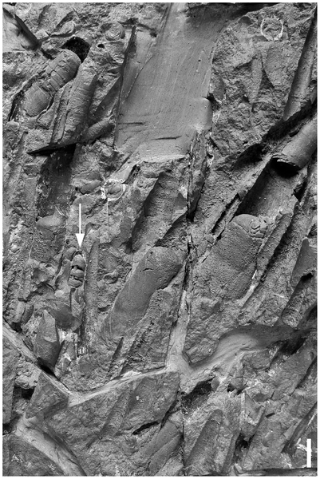During the Ordovician the global diversity increased dramatically at family, genus and species levels. Partially the diversification is explained by an increased nutrient, and phytoplankton availability in the open water. Cephalopods are among the top predators of todays open oceans. Their Ordovician occurrences, diversity evolution and abundance pattern potentially provides information on the evolution of the pelagic food chain.
Methodology/Principal Findings
We reconstructed the cephalopod departure from originally exclusively neritic habitats into the pelagic zone by the compilation of occurrence data in offshore paleoenvironments from the Paleobiology Database, and from own data, by evidence of the functional morphology, and the taphonomy of selected cephalopod faunas. The occurrence data show, that cephalopod associations in offshore depositional settings and black shales are characterized by a specific composition, often dominated by orthocerids and lituitids. The siphuncle and conch form of these cephalopods indicate a dominant lifestyle as pelagic, vertical migrants. The frequency distribution of conch sizes and the pattern of epibionts indicate an autochthonous origin of the majority of orthocerid and lituitid shells. The consistent concentration of these cephalopods in deep subtidal sediments, starting from the middle Tremadocian indicates the occupation of the pelagic zone early in the Early Ordovician and a subsequent diversification which peaked during the Darriwilian.

Nodule with masses of orthoconic nautiloids from La Maurerie Formation, earliest Floian, Montagne Noire, France.
Arrow highlights Bactroceras. Scale bar equals 1 cm.
doi:10.1371/journal.pone.0007262.g001
![Early Ordovician cephalopod occurrences in distal and deep marine depositional settings. Map simplified from [97]. doi:10.1371/journal.pone.0007262.g002](http://worldfossilsociety.org/wp-content/uploads/2013/04/121219174150-large4.png)
Early Ordovician cephalopod occurrences in distal and deep marine depositional settings.
Map simplified from Cocks LRM, Torsvik TH (2004).
doi:10.1371/journal.pone.0007262.g002

Habitats of selected Late Ordovician cephalopods (dotted lines).
doi:10.1371/journal.pone.0007262.g010
Conclusions/Significance
The exploitation of the pelagic realm started synchronously in several independent invertebrate clades during the latest Cambrian to Middle Ordovician. The initial rise and diversification of pelagic cephalopods during the Early and Middle Ordovician indicates the establishment of a pelagic food chain sustainable enough for the development of a diverse fauna of large predators. The earliest pelagic cephalopods were slowly swimming vertical migrants. The appearance and early diversification of pelagic cephalopods is interpreted as a consequence of the increased food availability in the open water since the latest Cambrian.
Citation: Kröger B, Servais T, Zhang Y (2009) The Origin and Initial Rise of Pelagic Cephalopods in the Ordovician. PLoS ONE 4(9): e7262. doi:10.1371/journal.pone.0007262
Editor: Matthew Kosnik, Smithsonian Institution, National Museum of Natural History, United States of America



 April 12th, 2013
April 12th, 2013  Riffin
Riffin  Posted in
Posted in  Tags:
Tags: 